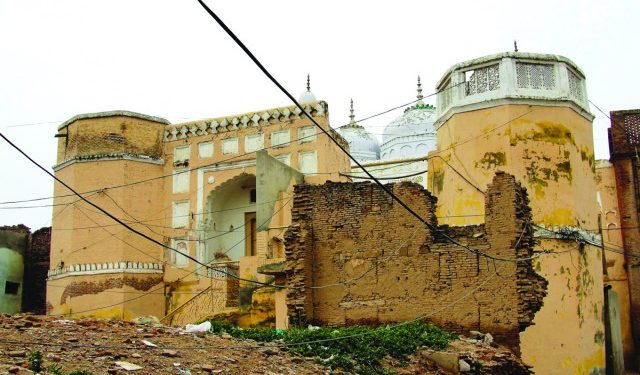
Beside some historic mosques, there are about eight temples in different localities of Bhera town
Zulfiqar Ali Kalhoro
Bhera in Sargodha district is one of the historic towns which boasts many remarkable old buildings, noticeable for their impressive embellishments. One comes across impressive havelis with ornate carved wooden doors, splendid jharokhas and balconies. Walking in streets of Bhera opens to the visitor the rich past vista of this town.
Bhera town is noted for the historical monuments of the Muslims, Sikhs and Hindus. Every street of Bhera town has a historic building, either belonging to the Muslims, Sikhs or Hindus. Today, Hindus or Sikhs do not live in the town but their monuments still reflect the identity of these communities.
There are many historical mosques in Bhera town of which the mosques of Tughlaq, Khalji and Suri periods are quite prominent. The list of historical mosques in Bhera is long. The Qazianwali mosque, Haafizani mosque, Peeranwali mosque, Gondianwali mosques, Hakimwali mosque, Jamia Masjid Mohajirin in Pakhiwaran Mohalla are some of Bhera town’s well known historical mosques.
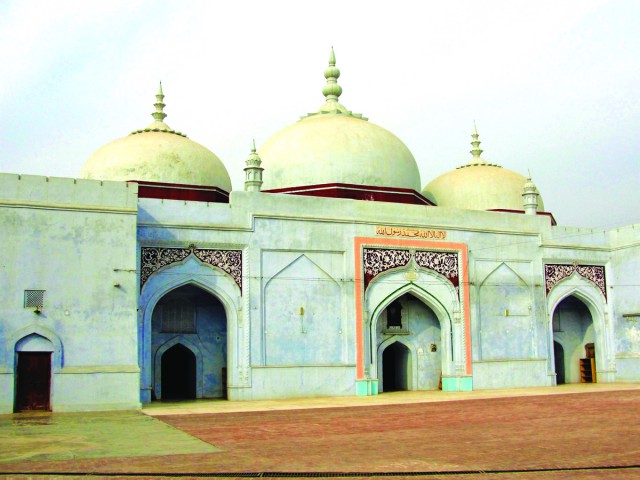
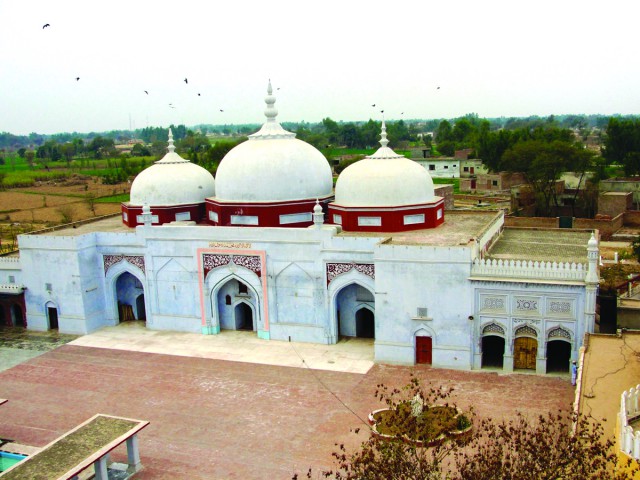
The so-called mosques of Khalji and Suri periods still retain their old grandeur. The Khalji mosque in Sheikhananwala Mohalla is noted for its monumental gate. It is believed that Sheikhanwala Mohalla was established during the Khalji period (1290-1320). But its architecture appears to be of the Mughal period. The mosque was likely rebuilt by the Mughals. As such, the mosque is noted for its elegant three domes and two turrets which add beauty to the structure. The façade of the mosque is now whitewashed but one can still see traces of the original decorative work on the walls, particularly on its main gate. The two octagonal towers on either side of the gate reflect the typical early Mughal style. However, the local people associate this mosque with the Khaljis. The boundary walls of the mosque look like a fortress reflecting the typical Central Asian style of mosque building. The renovation work has damaged the original beauty of the mosque. Formerly, the mosque had a painted exterior. However, there are still some paintings inside the mosque.
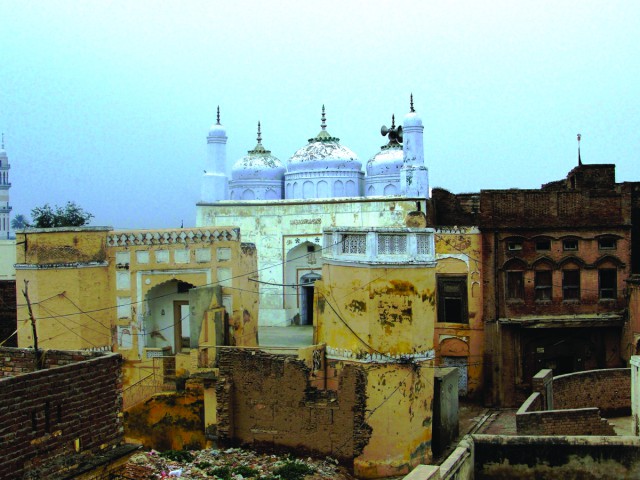
Another mosque believed to have been built by Sher Shah Suri in 1541 – the year that is inscribed on the entrance of the mosque – has also been renovated. The mosque has three domes and arched entrances. But this mosque is entirely different from the one built by Sher Shah Suri at Rohtas which is noted for its intricate decoration. Sher Shah Suri was a great builder. He is believed to have built many forts, mosques, baolis, sarais (inns) and tombs. He also excavated baolis (stepped wells) and built sarais on the GT Road for the travelers and his soldiers.
The boundary walls of the mosque look like a fortress, reflecting the typical Central Asian style of mosque-building
The Jamia Masjid of Bhera was rebuilt by Qazi Ahmeduddin Bugvi in 1860 and later on repaired by Qazi Zahoor Ahmed Bugvi in 1926. The name of the mason, Muhammad Asif, is also mentioned in the inscription. The foundation of the mosque has its origins in the time of Sher Shah Suri, whereas the superstructure was rebuilt by Ahmeduddin Bugvi.
With the help of Col (rtd) Zahid Mumtaz, Sahibzada Abrar Ahmed set up a library and the Bhera Information and Research Centre at the mosque. The library has the original architectural design of the mosque and about 300 invaluable manuscripts with a copy of Ain-i-Akbari and 10 copies of the Holy Quran from the Suri and Mughal periods. These manuscripts on the Suri and Mughal periods are very useful for research workers.
Apart from mosques, there are also several havelis, temples and gurdwaras in Bhera town. The spectacular havelis and impressive temples are located in different mohallas of the town.
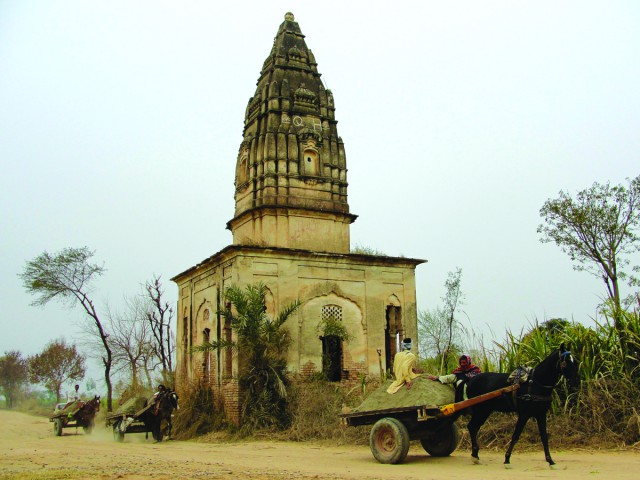
There are about eight temples in different mohallas of Bhera town: in Sheikhwala mohalla, Nagianwala mohallas, Baoliwala, Khawjgan, Chirih Chong and Gang wala Darwza etc of which three have almost been leveled to the ground whereas the others are also in a crumbling condition.
The Boliwala Mandir, the mandir in Sheikhanwala Mohallah and the Shiva mandir are the most impressive structures that have withstood against the vagaries of weather. The Boliwala mandir lies on the road that leads to the Jhelum River. The elevated summit of the temple is conspicuous from a distance. The temple lies deserted and the lower part where the sacred image was placed (garbhagriha) is in a bad state of preservation. The temple has three openings from four directions. It features also basement cells which were possibly used for mediation. There is pradakshina (circumambulatory gallery) around the garbhagirha. On the top of the entrance gate was an inscription tablet which was taken away possibly by the concerned authorities or else by treasure-hunters.
The entrance gate of the temple is in an appalling condition. The stairways leading to the main chamber of the temple are all broken. Now, the main chamber (garbhagirha) is full of fallen debris. The shikhara (superstructure) of the temple is still in good condition. The niches which were apparently made to place images (murtis) have also been damaged by people.
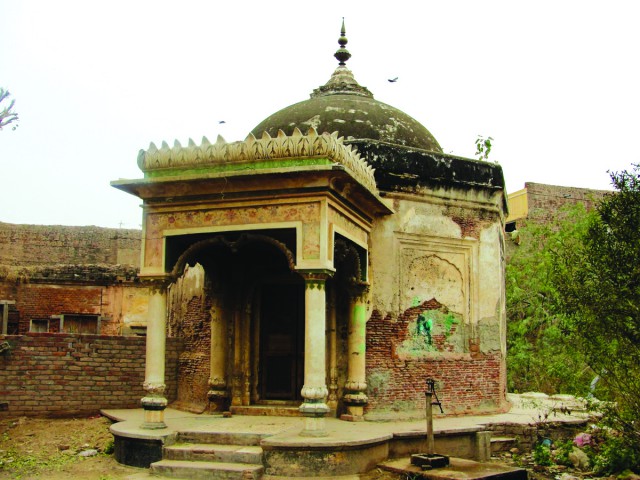
Another Hindu temple is located in Nagianwala mohalla. This temple is dedicated to the god Shiva who was the first guru or lord of the yogis. The Nath yogis are Shaivite renouncers and take Shiva as the first guru followed by Machhindar Nath, Gorakh Nath, Jalander Nath and Kanipav etc. The temple was believed to have been built by Jogis. They were famous for their ascetic practices or tapas. As such, the Pothohar region was a centre of the Jogis with the main headquarters situated at the Tilla Jogian in Jhelum district. There are many places in Pothohar region which are associated with Jogis. One of such places is located at Bagh Joghain in Islamabad where there were some structures, probably Samadhis (now destroyed) of the Nath Jogis.
The temple of Shiva in Bhera town is associated with Nath jogis. There are also eight Samadhis of the Nath Jogis on the podium of the temple. Nath jogis bury their dead near their homes or at the temples rather than cremating them as is the custom for other Hindu castes. Their place of burial is referred to as Samadhi, the final resting place of the world-renouncers. The Nath Jogis used to wear ochre-coloured clothes, which were called bhagva. It is likely that the name Bhera is derived from the word bhagva because the religious structures of Nath Jogis were once numerous in and around Bhera in general and Jhelum in particular.
The distinctive feature of the temple is the mandapa (columned hall that precedes the main chamber of a temple). The pillars of the mandapa are decorated with the images of Shiva in yogic postures. One of the pillars of the temple is also decorated with a painting of Brahma. The temple is built in an octagonal plan superimposed with a dome. It looks like a Muslim tomb but the religious paintings make it a distinctive Hindu structure.
Apart from these two temples, another is situated in Sheikhanwala mohalla. It is noted for its elegant shikhara. This, too is a squared building.
Apart from Hindu temples, there are also gurdwaras and a Jain temple in Bhera, all of which have lost their original beauty. The Jain temple is noted for beautiful woodwork which has deteriorated now. The paintings that once decorated the interior and exterior of the temple have also disappeared now.
_________________
 Dr. Zulfiqar Ali Kalhoro is an anthropologist and author of 12 books including ‘Symbols in Stone: The Rock Art of Sindh’, ‘Perspectives on the art and architecture of Sindh’, ‘Memorial Stones: Tharparkar’ and ‘Archaeology, Religion and Art in Sindh’. He may be contacted at: zulfi04@hotmail.com
Dr. Zulfiqar Ali Kalhoro is an anthropologist and author of 12 books including ‘Symbols in Stone: The Rock Art of Sindh’, ‘Perspectives on the art and architecture of Sindh’, ‘Memorial Stones: Tharparkar’ and ‘Archaeology, Religion and Art in Sindh’. He may be contacted at: zulfi04@hotmail.com
Courtesy: The Friday Times Lahore